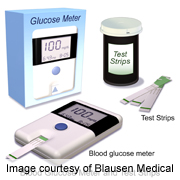
A project of the U.S. Department of Health and Human Services Office on Women's Health



FRIDAY, Feb. 15 (HealthDay News) -- A couple of decades ago, only 2 percent of people with any type of diabetes met or exceeded the three measures of good diabetes management. By 2010, that number had risen to 19 percent, according to new government research.
These measures of good diabetes management are average blood sugar, blood pressure and cholesterol levels. When researchers looked at each measure independently, more than half of people in the study met individual measures.
"Overall, there was a huge improvement between 1988 and 2010. These findings are very encouraging. However, only 19 percent of people were meeting all three goals," said senior study author Catherine Cowie, director of the Diabetes Epidemiology Program at the U.S. National Institute of Diabetes and Digestive and Kidney Diseases.
One expert had mixed reactions to the study results.
"I see these findings as the glass is half full and half empty. With so much more awareness of diabetes and with newer medications, it's very disappointing to see only 19 percent with good management," said Dr. Joel Zonszein, director of the Clinical Diabetes Center at Montefiore Medical Center in New York City.
"If you look at the LDL [bad] cholesterol, only half were on [cholesterol-lowering drugs called] statins, but 100 percent of people with diabetes should be on statins. Only half were well-treated for their blood pressure. That means half of the people with diabetes aren't being treated for blood pressure. I see this as a big problem," Zonszein said.
The study was published online Feb. 15 in Diabetes Care.
The three measures of diabetes management are sometimes called the ABC's of diabetes. "A" is hemoglobin A1C, an estimate of blood sugar levels over the past three months. A1C is expressed as a percentage, and specific A1C goals should be determined by an individual's doctor, but the American Diabetes Association generally recommends that people with diabetes aim for an A1C of less than 7 percent.
The "B" is blood pressure, and the association advises that people with diabetes should have blood pressure of 130/80 millimeters of mercury (mmHg) or less. And "C" is cholesterol, specifically LDL cholesterol. For people with diabetes, the association advises LDL levels be below 100 milligrams per deciliter (mg/dL).
It's important to keep these measures as close to the recommended goals as possible to avoid serious complications, such as heart disease, kidney failure and vision problems.
The researchers reviewed data from four U.S. National Health and Nutrition Examination Surveys, which were done from 1988 to 1994, from 1999 to 2002, 2003 to 2006, and 2007 to 2010. Nearly 5,000 study volunteers said they had diabetes but didn't specify what type they had. All were older than 20.
In 2010, almost 53 percent of those in the study achieved an A1C of less than 7 percent. Fifty-one percent made the blood pressure goal, and 56 percent achieved the cholesterol goal. But, fewer than one in five achieved all three goals.
Some groups fared worse than others. Young people and Mexican-Americans were least likely to meet their blood sugar goals. Forty-four percent of Mexican-Americans made their blood sugar goals in 2010, compared to 53 percent of whites and blacks. Just 49 percent of young people (aged 20 to 49) made their blood sugar goals, while 58 percent of people over 65 did.
Fifty-three percent of whites, 44 percent of blacks and about 48 percent of Hispanics and Mexican-Americans met the blood pressure goal, according to the study.
On cholesterol levels, 55 percent of whites, 45 percent of Mexican-Americans and 48 percent of blacks and Hispanics met the goal.
Cowie said it's clear that public health efforts need to reach out more to minority groups.
Zonszein said the racial disparity issue is complex, but that more education and greater access to regular care and medications could help everyone.
Both experts said the fact that many young people aren't managing their diabetes is particularly troubling.
"Young people were not meeting the A1C goals as much as we would've liked to see. The concern is that they have more time to develop complications because they will have the disease for a long time," Cowie said.
Another worry, Zonszein said, is that type 2 diabetes that occurs in young people seems to be a particularly aggressive form of the disease.
"They respond much less to insulin and are much more insulin-resistant. They will develop more complications at a young age," he said.
Zonszein said education is key for all people with diabetes. "Right now, people often don't get education until late in the disease. But, people need to know why they need these medications," he said. "It's hard to take all these pills when you feel well, so you have to know what's going on and what the medications can do. If you don't know your disease, you won't take the medications for the long term."
"I see this paper as an alarm," Zonszein added. With current rates of obesity, and the increasing number of people being diagnosed with diabetes, especially type 2, he said, the health care system may be overwhelmed with younger, sicker people with serious diabetes complications if only a fraction achieve optimal diabetes management.
More information
Learn more about steps you can take to manage diabetes well from the National Diabetes Education Program.